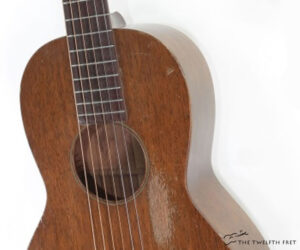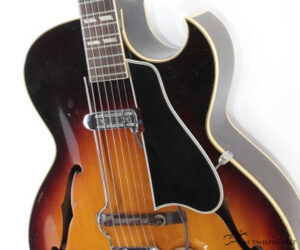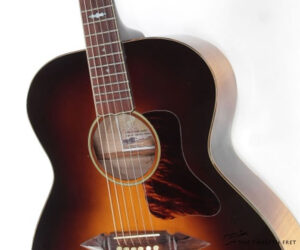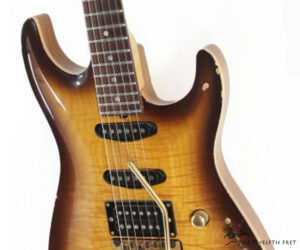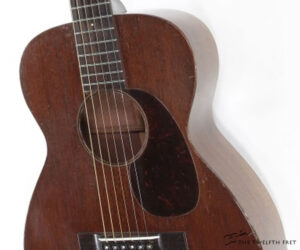Here we’re looking at a Martin 2-17 #25 built during early 1930 in Nazareth, Pennsylvania, showing a 1929 feature – a straight saddle. Not long after this guitar was built, Martin shifted to slanted saddles, giving the bass strings a little more length for intonation purposes. Apparently 449 were built during 1930 with this saddle, and 50 with the slanted saddle.
Brazilian Rosewood
This spectacular Bourgeois Custom D LSH Large Sound Hole, 2015- is part of a series of instruments offered around the 2015 Summer NAMM show. Dated to June 5, 2015 at Lewiston Maine, this pairs an Adirondack Spruce top with premium Brazilian Rosewood for the sides, back and head plate.
Seen here is a Gibson L-4C cutaway archtop acoustic guitar with an original DeArmond Rhythm Chief 1100 pickup with its ‘Monkey on a Stick’ mount. This fine vintage guitar very much looks the part, and it plays well. The 16-inch wide Gibson L-4C was introduced in 1949 and came to replace the non-cutaway L-4. That model first appeared in 1912 as an oval-hole archtop, with F-holes becoming available in 1935 and finally discontinued in 1956.
Here is a rarity! A John Greven Prairie State Model ‘Doug Jones Special’ jumbo steel string from the early 2000’s. This beautiful piece is built with a Spruce top, Flame Maple for the back, sides and neck, and Brazilian Rosewood for the bridge and bound fingerboard. The binding, heel cap, head plate and pickguard are faux tortoise. Tuners are Waverly open gear models with creme plastic buttons.
Shown here is a Pensa Custom MK-1 built during 1995 in New York City by Rudy Pensa. The MK designation stands for Mark Knopfler. The original MK model was designed by Pensa and Knopfler to create a guitar capable of sounding like the 1961 Strat and 1958 Les Paul Knopfler was using on stage, allowing him to use only one guitar.
The Martin 0-17 has at least two major distinctions, as one of Martin’s oldest defined styles, and their first production steel string model. Martin’s Style 17 first appeared in 1874 as a fairly plain model, and was discontinued from 1898 to 1906.
